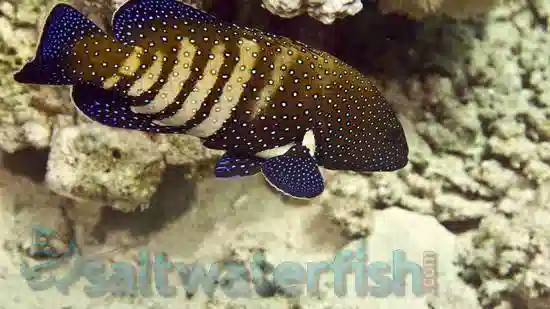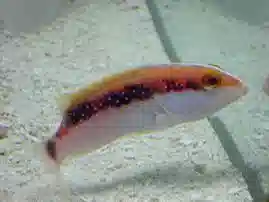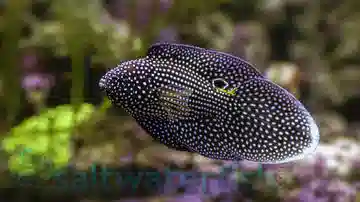Blue Spot Grouper
Cephalopholis argus
(1 Reviews)

Blue Spot Grouper
Cephalopholis argus
(1 Reviews)
{{ item.name }}
Size: {{ item.extra_field_3 }}
${{ getFormattedPrice(item.saleprice) }} ${{ getFormattedPrice(item.price) }}
To join the waiting list, click here
Free Shipping
With
$199.00
or more in Marine Life.
More details...
Blue Spot Grouper Care Facts
| Care Level: | Moderate |
|---|---|
| Temperament: | Aggressive |
| Diet: | Carnivore |
| Reef Safe: | No |
| Minimum Tank Size: | 200 gallons |
| Max Size: | 24 inches |
The Blue Spot Grouper (Cephalopholis argus), also known as the Peacock Hind, Argus Hind and Blue-Spotted Grouper is a beautiful and hardy, albeit very aggressive, fish from the Indo-Pacific Ocean, as well as the coast of Hawaii. They are a sea bass from the family Serranidae, the Blue Spot Grouper feeds primarily on other fish in the wild, although it will also consume crustaceans; expect the same in your aquarium. For the large fish-only system with equally large fishes, the blue spot grouper is one of the more attractive members of the genus and should be given careful consideration. This fish appreciates low light environments with a couple of solidly constructed caves (these fish will dig). Only one blue dot grouper should be kept to a tank. A diet of meaty chunks (such as raw table shrimp) or a frozen food formulated for marine carnivores should be offered. While the blue spot grouper may appear shy on introduction, in short order, it will prove a personable, disease resistant, beautiful fish for the large fish-only (FOWLR) marine aquarium.
The Blue Spot Grouper (Cephalopholis argus): A Captivating Addition to Your Saltwater Aquarium
The Blue Spot Grouper (Cephalopholis argus) is a captivating addition to saltwater marine aquariums, admired for its striking appearance and intriguing behaviors. This species, originating from the Indo-Pacific region, has become popular among hobbyists due to its vibrant colors and moderate care requirements.
Habitat: Indo-Pacific Marvels
In their natural habitat, Blue Spot Groupers are found in coral reefs, rocky areas, and seagrass beds, often preferring depths ranging from 10 to 100 feet. To replicate their native environment, providing ample hiding spots within the aquarium, such as caves and overhangs, is recommended.
Reef Compatibility: Caution in Reef Tanks
While Blue Spot Groupers are not considered reef-safe, caution is advised when introducing them to a reef tank. They may behave predatorily toward smaller fish and invertebrates, especially if they are not well-fed. Close monitoring and careful selection of tank mates are essential.
Size and Lifespan: Moderate Size, Long-Term Commitment
This species has a moderate size, with adults reaching lengths of up to 24 inches. In captivity, with proper care, Blue Spot Groupers can live for an impressive 10 to 15 years, making them a long-term commitment for dedicated aquarium enthusiasts.
Diet in Captivity: Carnivorous Predators
Blue Spot Groupers are carnivorous predators, primarily feeding on small fish and crustaceans in the wild. In captivity, their diet should consist of high-quality frozen or live foods supplemented with occasional vitamin-enriched pellets. Regular feeding helps maintain their health and reduces the likelihood of aggressive behavior.
Aquaculture Availability: Reliance on Responsible Sourcing
As of now, Blue Spot Groupers are not commonly aquacultured, making them more reliant on responsibly sourced wild specimens. It is essential to choose suppliers committed to sustainable practices, such as Saltwaterfish.com, to support the conservation of marine ecosystems.
Compatibility with Other Fish and Invertebrates: Choosing Suitable Tankmates
When selecting tank mates for Blue Spot Groupers, choosing species of similar size and temperament is crucial. Compatible tank mates include:
- Emperor Angelfish (Pomacanthus imperator).
- Antenneta Lionfish (Pterois antennata).
- Blue Throat Trigger (Xanthichthys auromarginatus).
- Bigeye Soldierfish (Myripristis jacobus).
- Long-Spine Porcupine Puffer (Diodon holocanthus).
Sexual Dimorphism: Challenging Identification
Distinguishing between male and female Blue Spot Groupers can be challenging, as they do not exhibit distinct sexual dimorphism. Determining gender may require observing their behavior during the breeding season, typically in their natural habitat.
Juvenile to Adult Coloration Changes: Aesthetic Transformations
Juvenile Blue Spot Groupers showcase a striking pattern of vibrant blue spots against a dark background, gradually transitioning into a more subdued coloration with age. The adult coloration includes an overall reddish-brown hue with fainter blue spots.
Temperament: Territorial and Somewhat Aggressive
Known for their territorial and somewhat aggressive nature, Blue Spot Groupers should be housed with caution, especially when introducing new tank mates. It is recommended to acclimate them carefully and monitor their behavior, ensuring a harmonious coexistence in the aquarium.
Tank Requirements: Creating a Suitable Habitat
To provide a suitable environment for Blue Spot Groupers, a minimum aquarium size of 200 gallons is recommended. The tank should feature a mix of live rock structures, caves, and open swimming areas. Adequate filtration, a protein skimmer, and regular water changes are crucial for optimal water quality.
Water Conditions: Parameters for Optimal Health
- pH: 8.1 - 8.4
- Salinity: 1.020 - 1.025
- Water Temperature: 72°F - 78°F
- Water Flow: Moderate water flow, simulating their natural habitat.
Other Common Names: Variations in Nomenclature
Blue Spot Groupers may be referred to by other common names, including Peacock Grouper and Argus Grouper.
Why Choose Blue Spot Grouper from Saltwaterfish.com: Trusted Source
Saltwaterfish.com is committed to providing responsibly sourced marine species, ensuring the well-being of the aquarium inhabitants and the ecosystems they come from. By choosing the Blue Spot Grouper from Saltwaterfish.com, customers support ethical practices and receive a healthy specimen backed by the expertise of a trusted supplier.
In conclusion, the Blue Spot Grouper adds a touch of the Indo-Pacific to saltwater marine aquariums, showcasing its vibrant colors and unique behaviors. With proper care and responsible sourcing, enthusiasts can enjoy the beauty and presence of this captivating species for many years.
Love this Blue Spot Grouper! He is so beautiful and such an interesting personality! He doesn't bother anyone and has actually become friends with our yellow wrasse! They swim attached at the hip looking for food! He is a very mellow swimmer who loves swimming through the rock work to find new caves. He is a little hard to feed when competing with quicker eaters, I let a couple pellets sink in front of him and sink a few spirulina flakes! I highly recommend him, he is sweet, beautiful, and easy!
Reviewed by: Shia M. on Sept. 12, 2021












